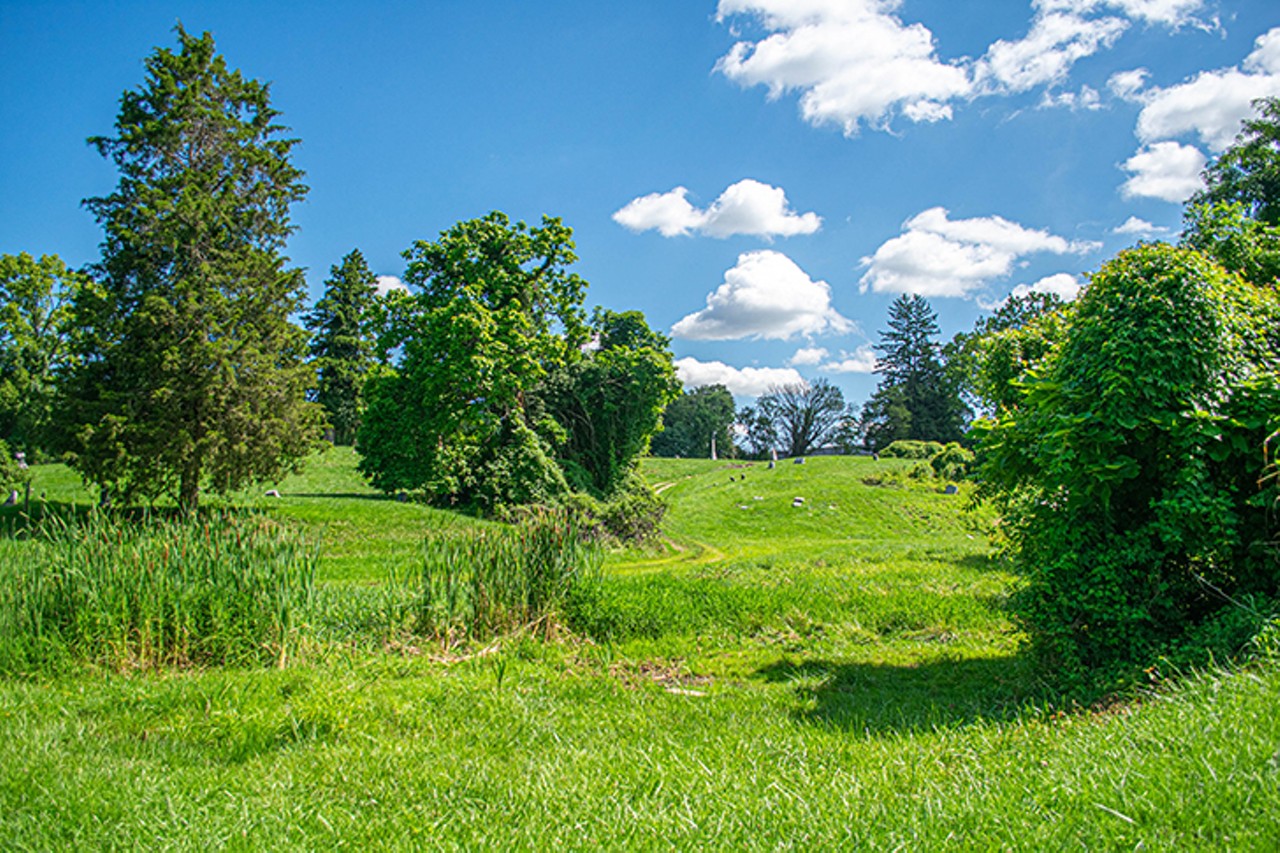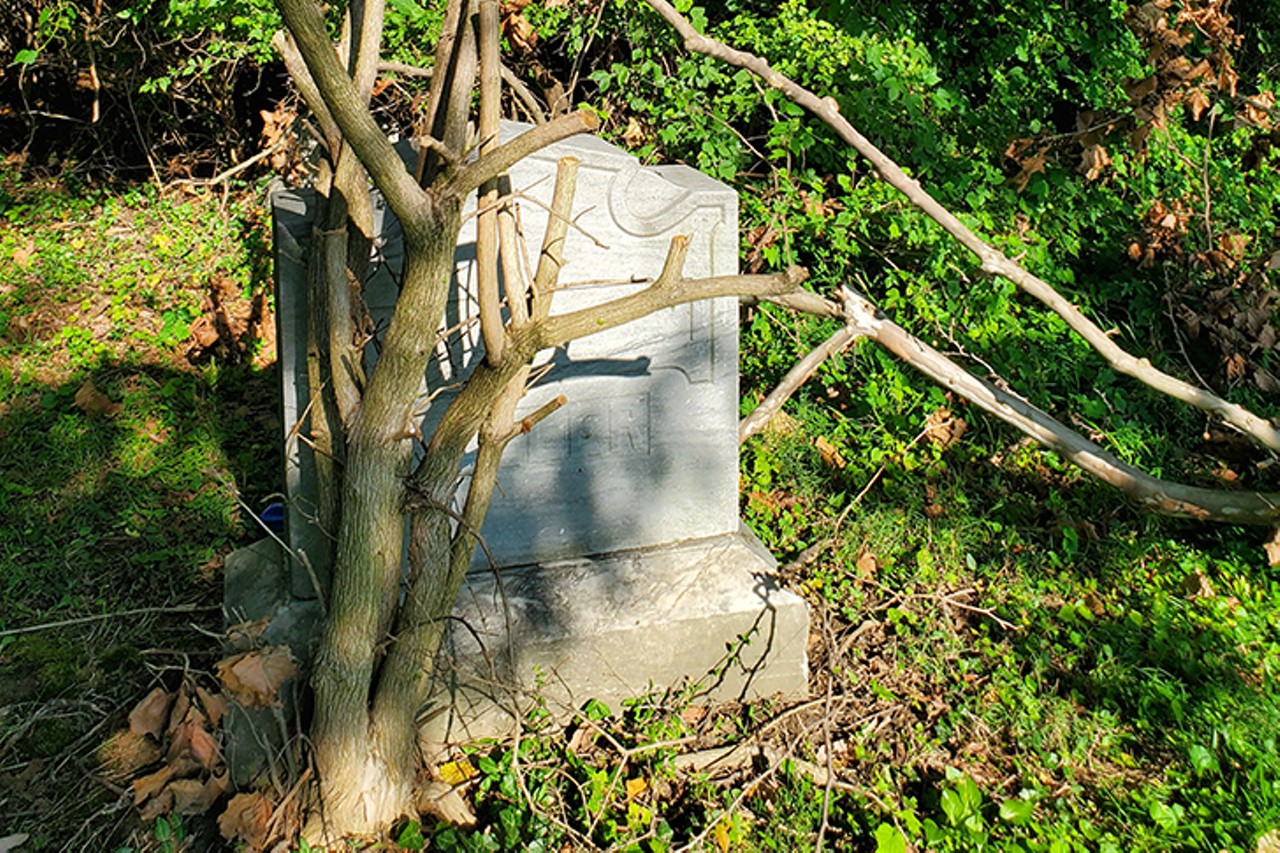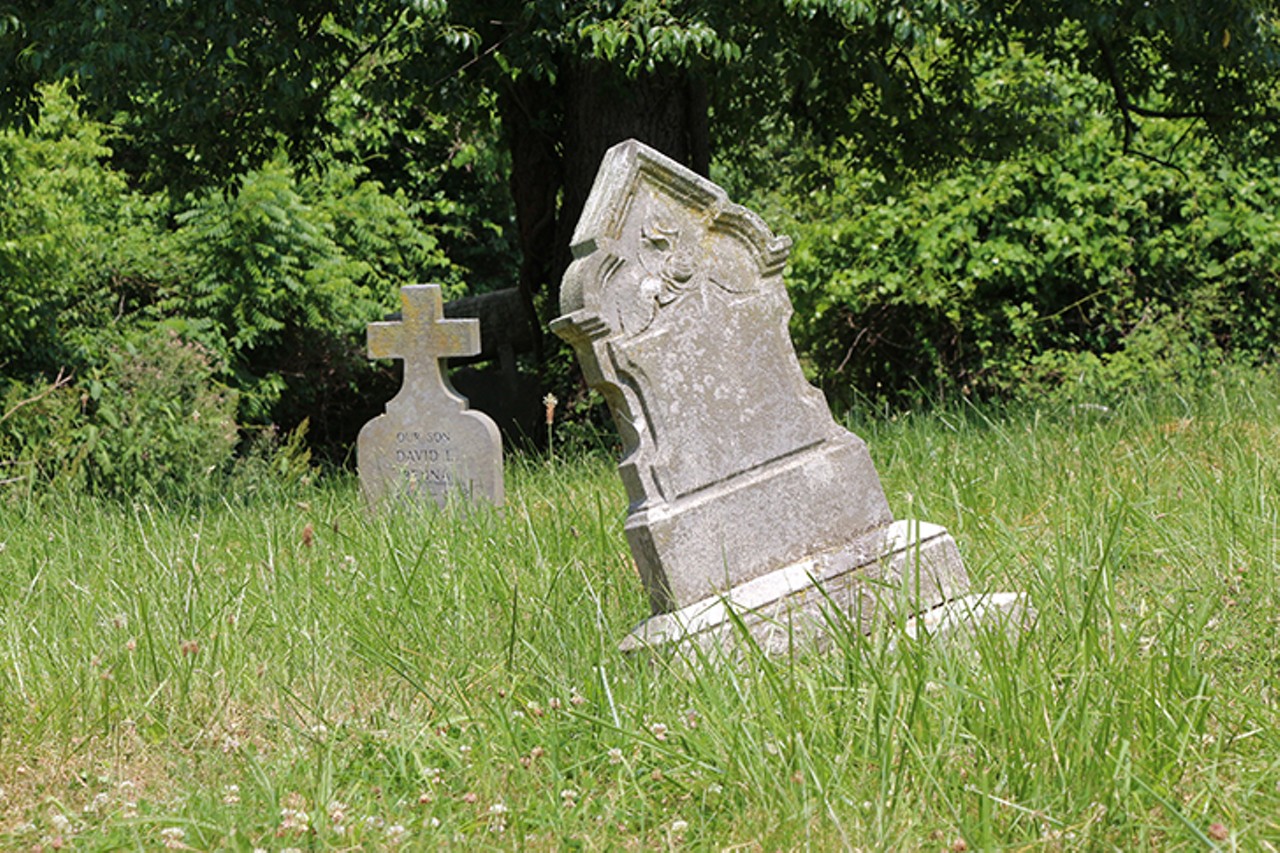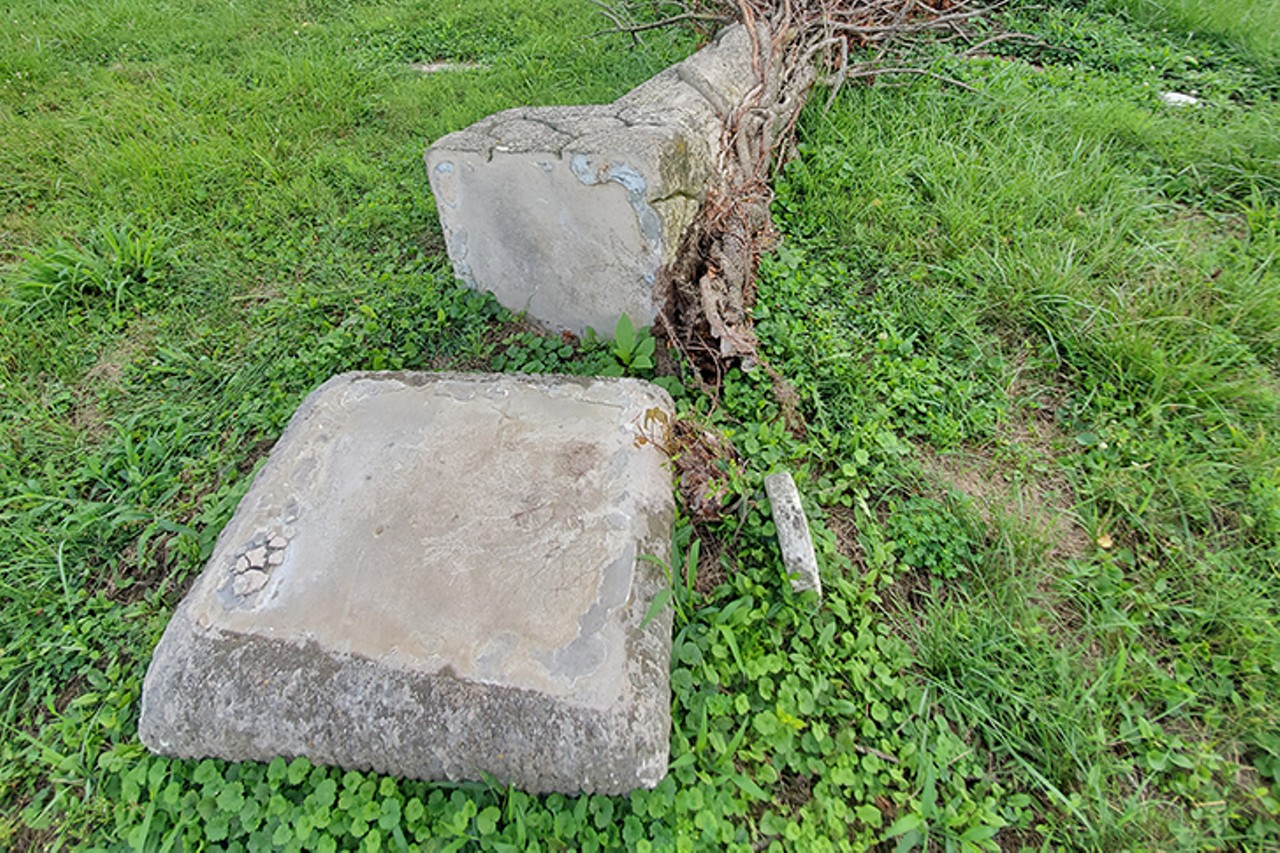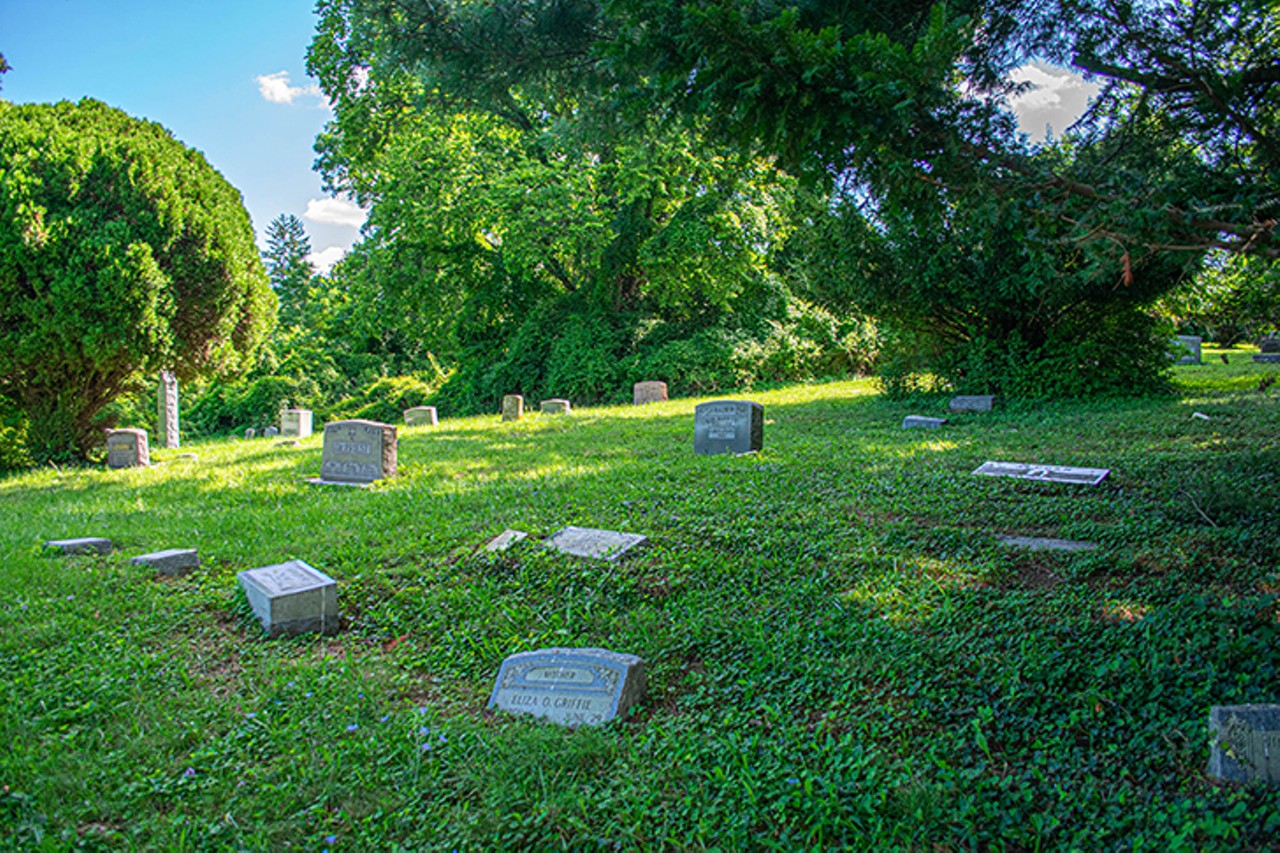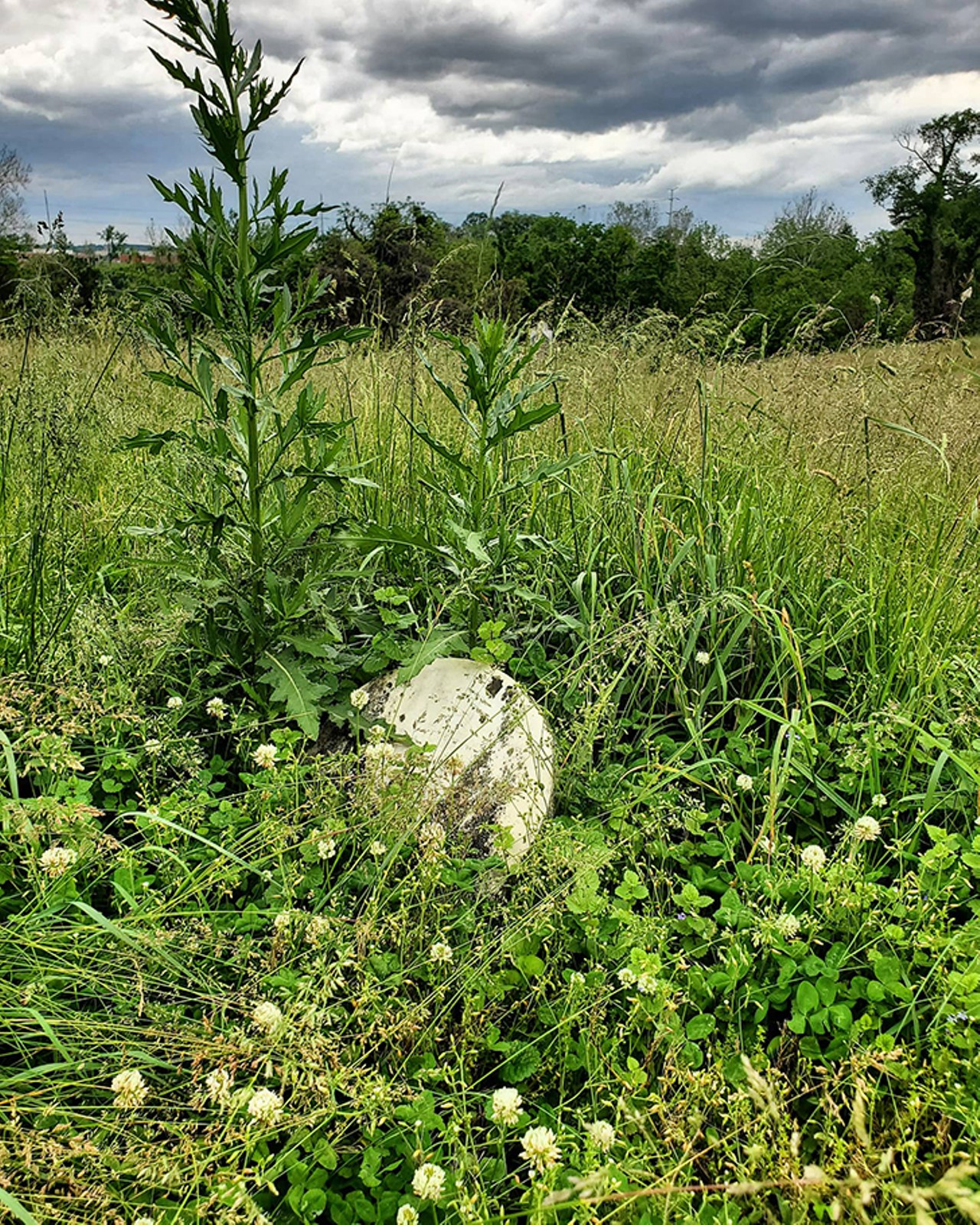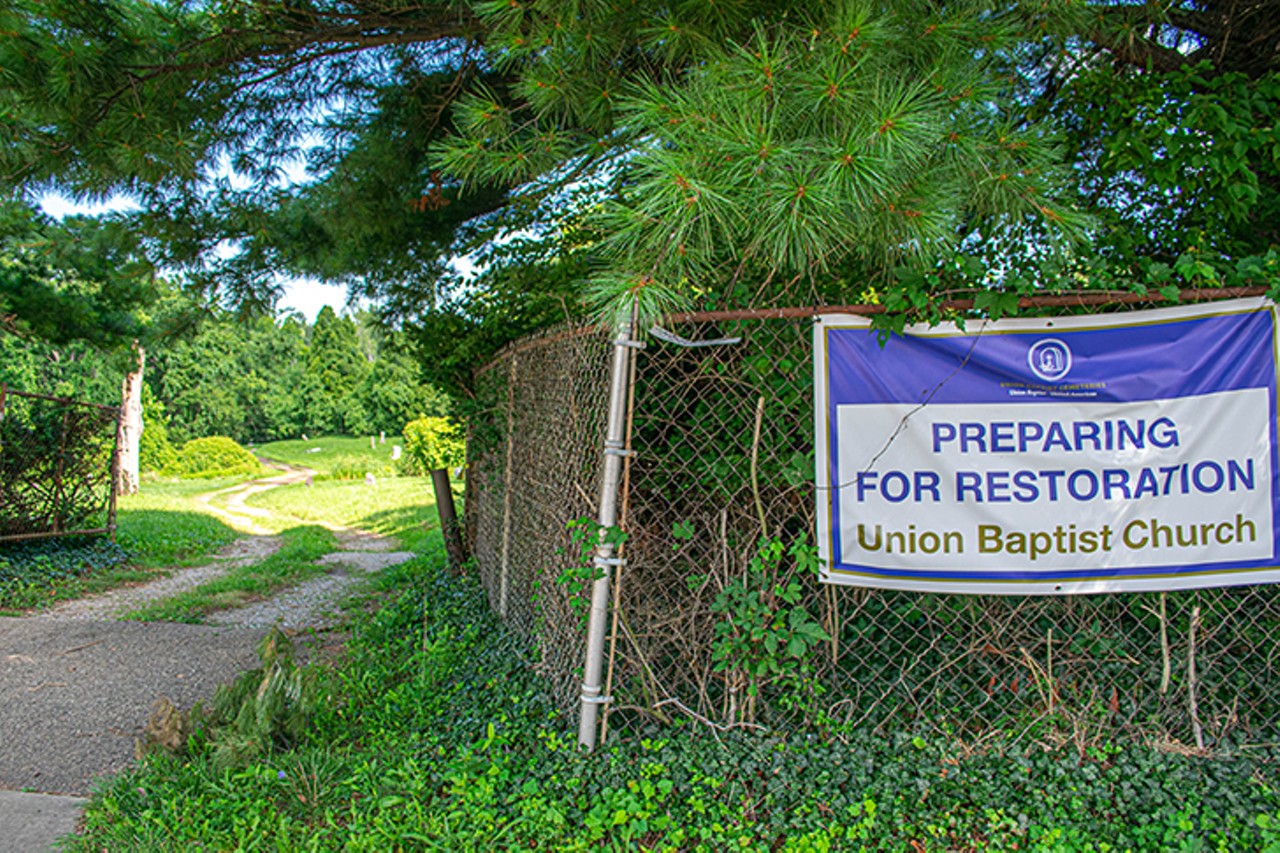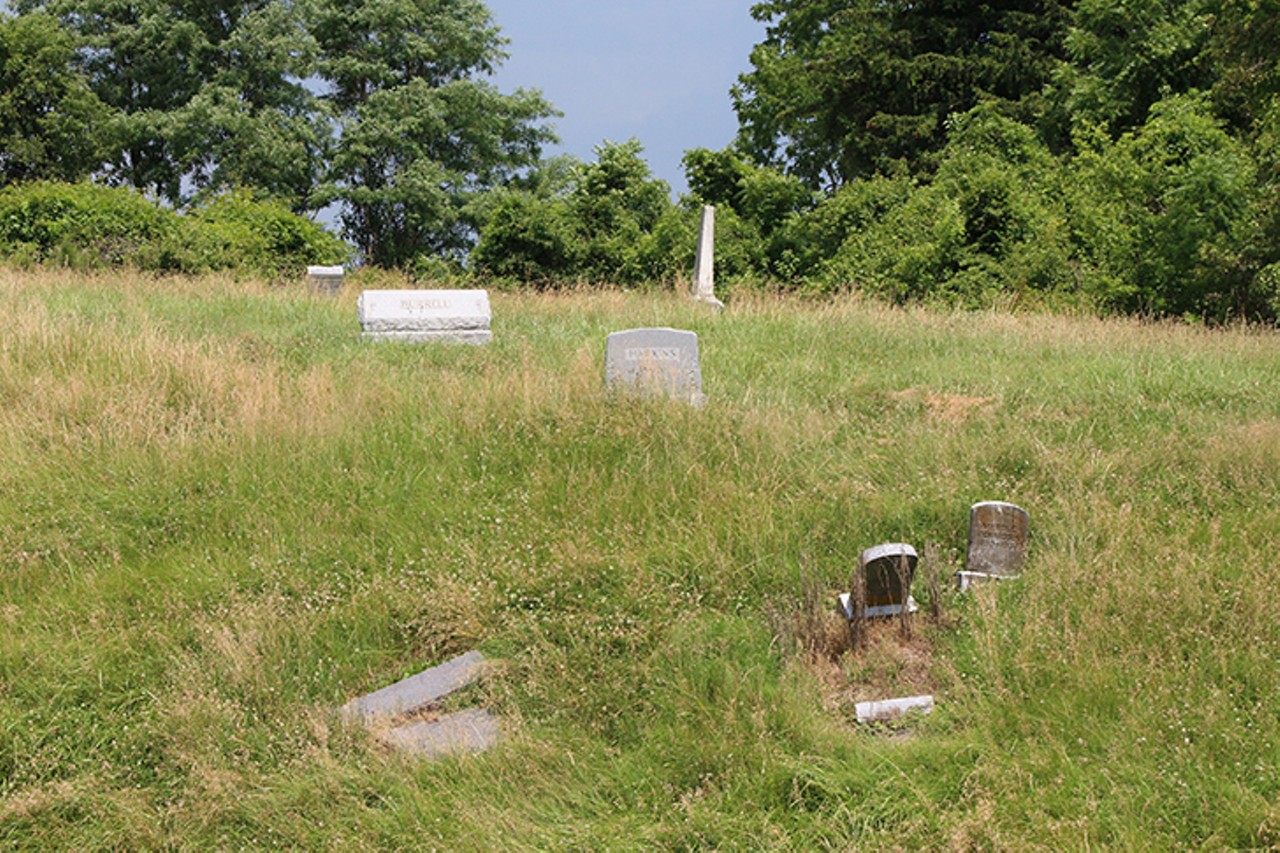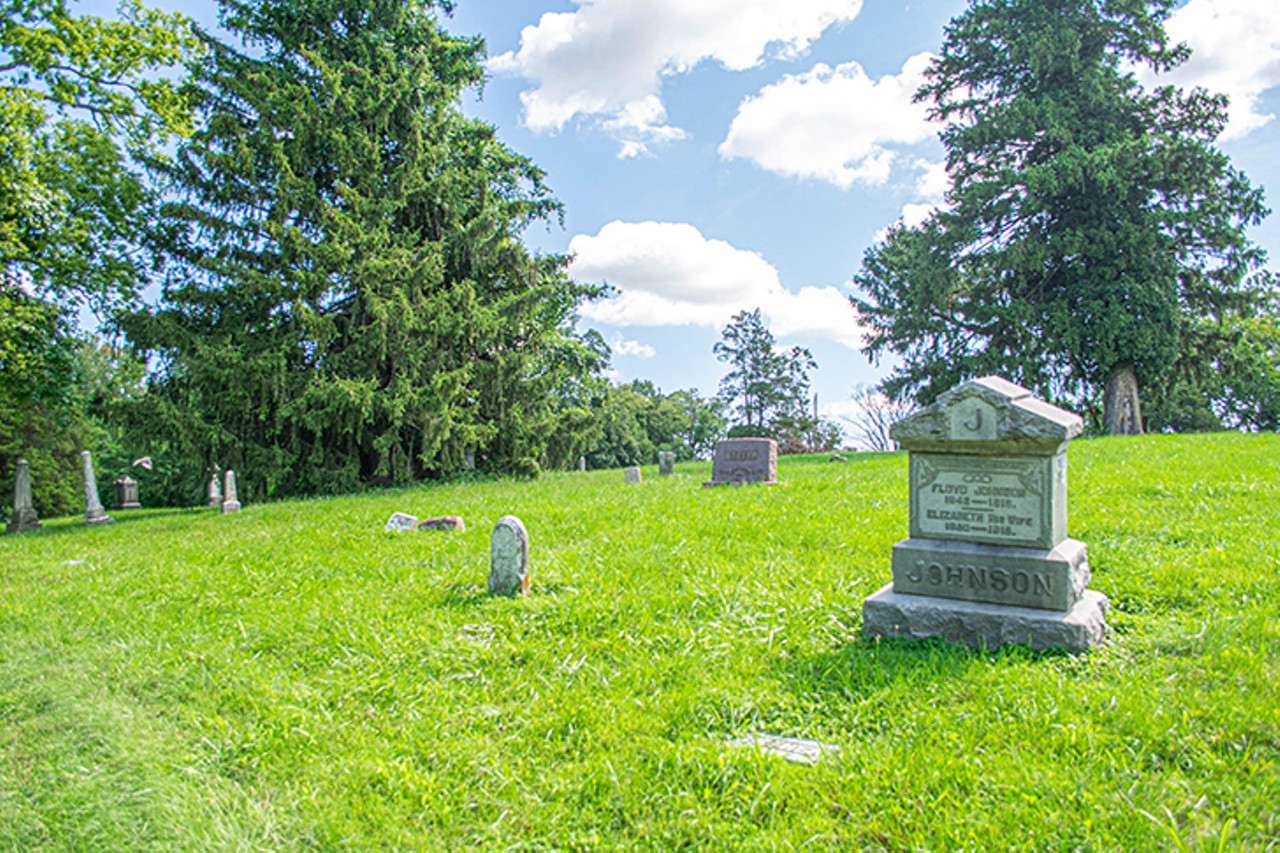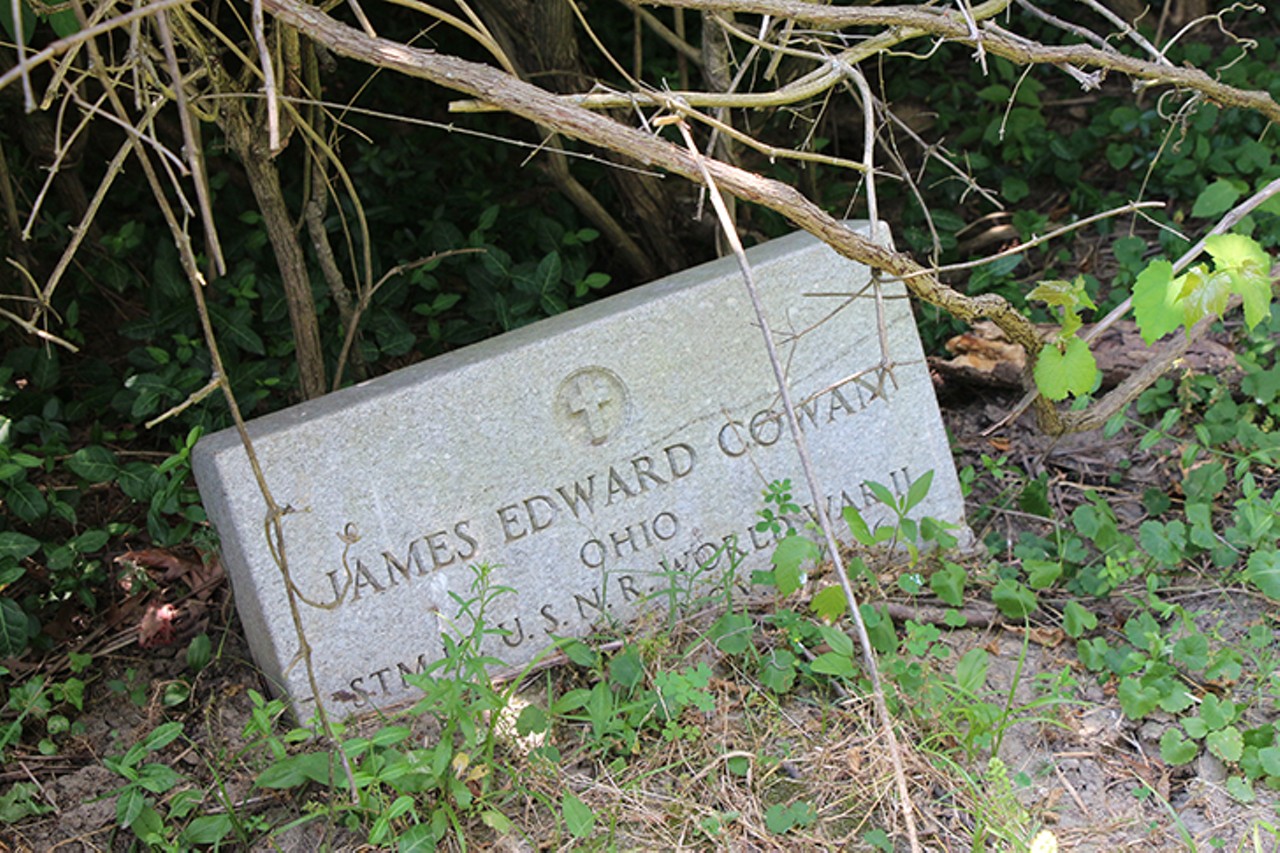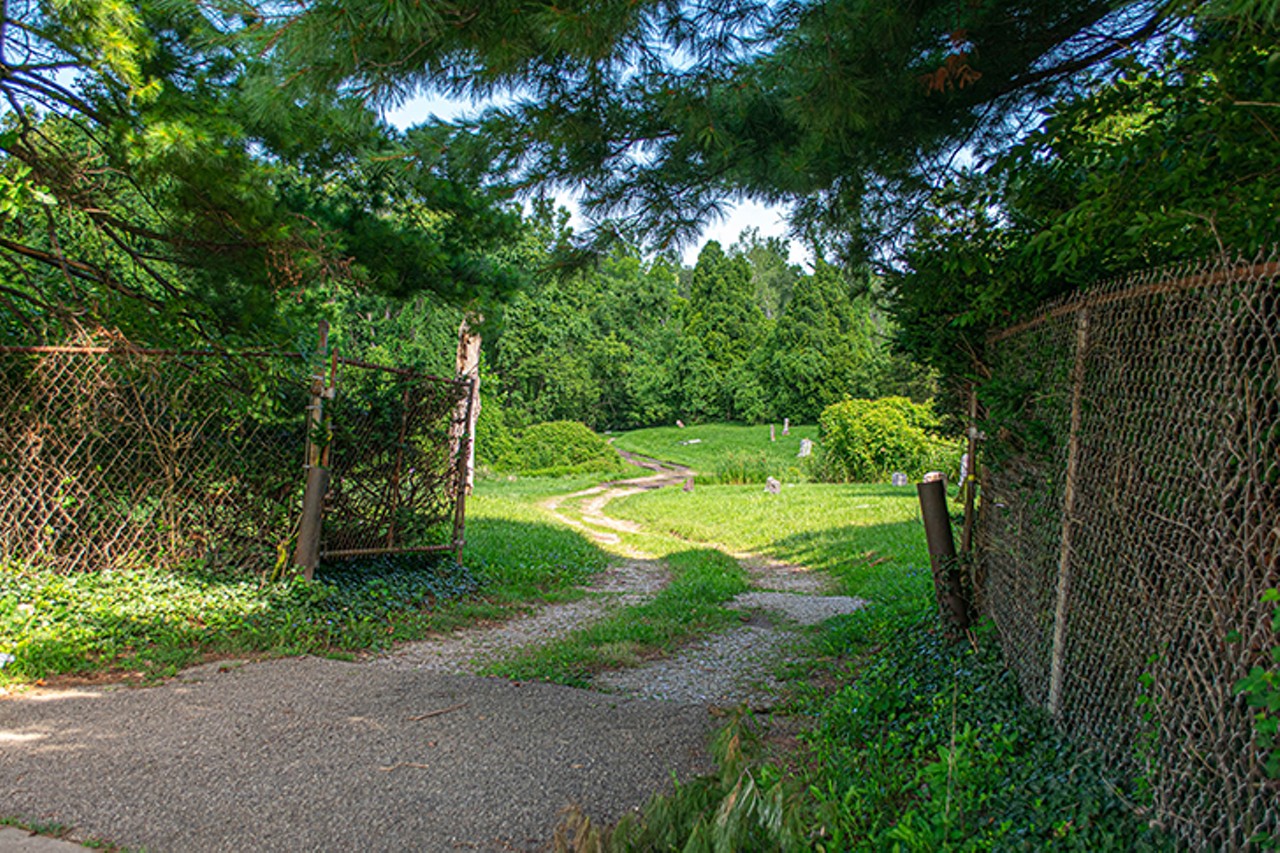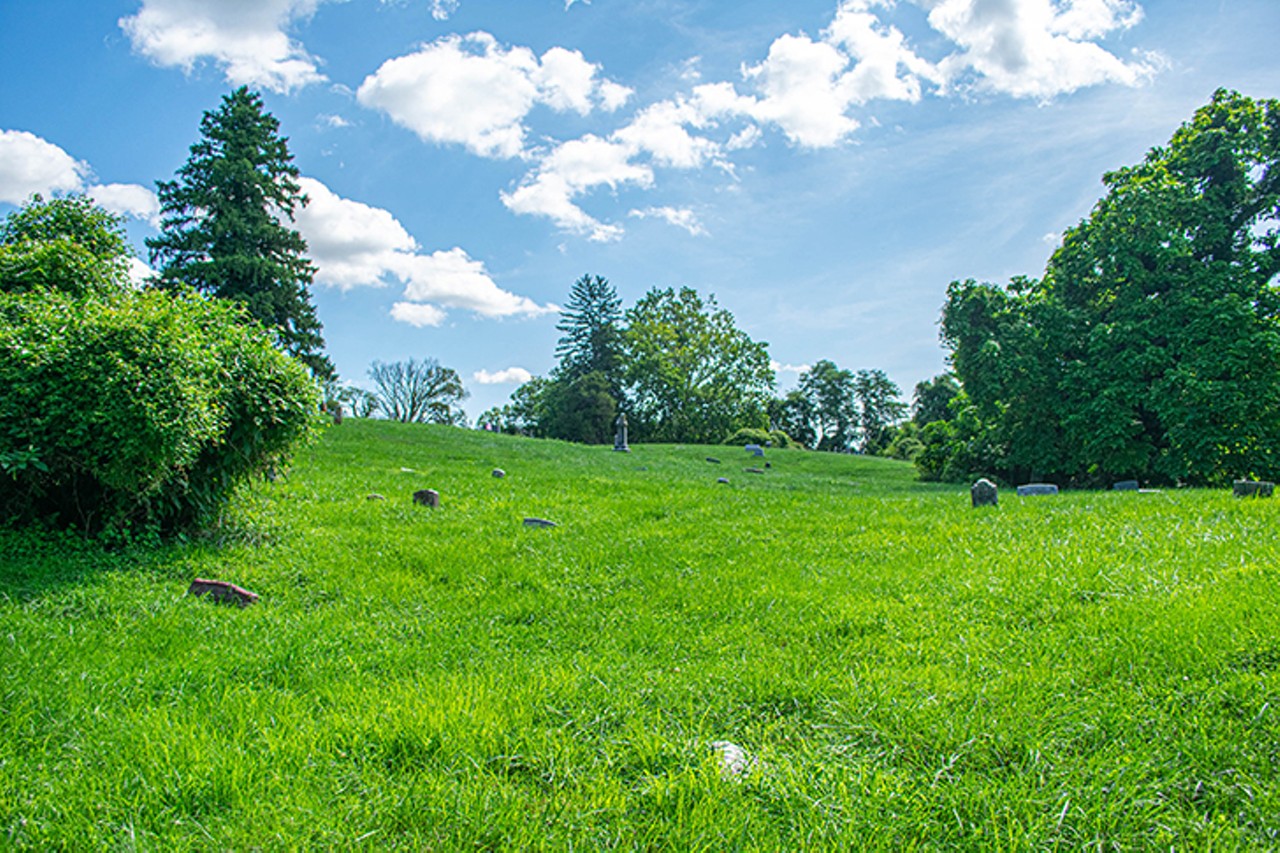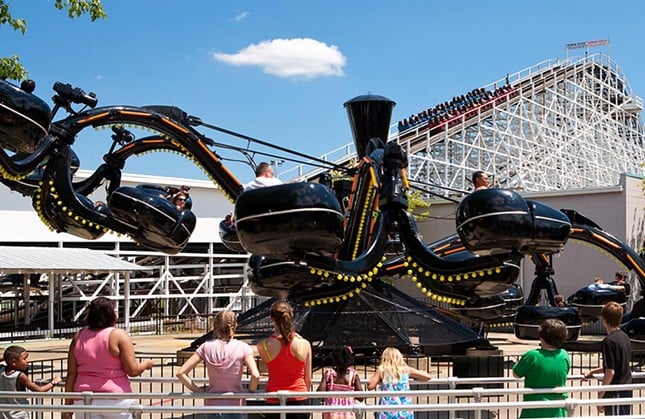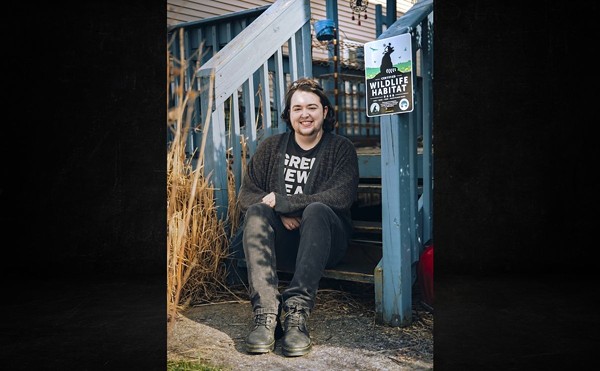Two cemetery associations were founded in Cincinnati in 1844. Both created burying grounds that were revolutionary in their own ways, but the tales of these two cities of the dead are remarkably divergent. The Cincinnati Horticulture Society produced Spring Grove Cemetery, and the United Colored American Association created United Colored American Cemetery, later shortened to United American Cemetery. While Spring Grove set a new bar for graveyard design, United American became the first respectable burying ground for Black Cincinnatians. Previously, Black people were buried in one of the city’s Potter’s Fields.
Today, Spring Grove is a source of municipal pride. It is the site of weddings as well as funerals. Its manicured beauty makes it a popular destination for leisurely walks or runs; and the cemetery offers guided walking tours. By contrast, United American looks derelict. Grave markers are sunken, overgrown, tilted or toppled.
United American is called the first Black cemetery in Ohio. But unlike Spring Grove, it did not set its sights on revolutionary design. The goal of its founders was simpler: dignity, honor, respect. And the Black community of Hamilton County took pride in the cemetery until it was attacked by an unlikely enemy.
Reverend George Williams was elected to the Ohio Legislature in 1879. A year later, he introduced a bill that would have forced United American to close and move out of its original location in Avondale. As the village had grown, some citizens thought that the land could be better allocated, and racism motivated a call for change. The county’s Black population fought the proposal.
What shocked and saddened the citizens that opposed closing the cemetery the most was that Williams was, himself, Black. Critics said that “the Rev. Hon. George W. Williams had been bought, and had sold his people out.”
With the aid of white legislators, the bill was quashed, and the cemetery was saved — temporarily.
In March 1883, United Colored American Association was formally incorporated. The Trustees, which included people who had fought Williams to save the cemetery, reportedly consulted with the families that owned burial plots and, based on a majority sentiment, sold the Avondale location and bought the current site on Duck Creek Road in Madisonville; but this version of events is doubtful. Families claimed that, in fact, “not one of the lot owners was consulted.” Trustees allegedly told families that if they did not pay to move loved ones’ remains at their own expense, “the bodies would be removed by the Trustees and thrown in a trench.” The plans were contested vociferously. Allegations of corruption and self-dealing abounded, but the sale was ultimately consummated, and generations of Black Hamilton Countians were reinterred.
What respect, or lack of it, was given to the bodies in the move is unclear, but the threat to throw bodies into a trench might explain why at least 12 African American veterans of the Civil War are now buried in United American in unmarked graves at unrecorded plots.
The new United American became the resting place of at least 41 veterans of the Civil War, 66 men who served in segregated units during World War I, and veterans from all the conflicts that followed. Humble, everyday folk are buried there alongside captains of industry and heroic community leaders like John Isom Gaines. Born in Cincinnati in 1821, Gaines was a fierce, outspoken abolitionist and a pioneer of public education.
In the decades that followed, United American continued to receive dignitaries of the community, people such as Horace Sudduth. As a young man, Sudduth worked as a Pullman train porter, providing gold star service to affluent travelers. During layovers, he had to stay in hotels. As a Black man in segregated America, this usually meant sleeping in flea bag joints. The experience stuck with him.
In the early 1900s, Sudduth became a real estate broker, later expanding into real estate investment and development. He became an extremely wealthy man with an avant-garde social conscience. Sudduth counseled his Black clients about real estate financing and loans, and in 1919 founded the Industrial Federal Savings and Loan Association, helping countless Black families become homeowners. He was elected president of the National Negro Business League, served as president of the New Orphan Asylum for Colored Youth, and in 1995 he posthumously became the first African American inducted into the Greater Cincinnati Business Hall of Fame. He was well known and highly respected for his philanthropy and his entrepreneurial success, but Sudduth was best known as the proprietor of the Manse Hotel in Walnut Hills.
The Manse fulfilled a pledge that Sudduth made as a young porter. If he could not end segregation, he could build a hotel that rivaled the best white-only marquee accommodations in Cincinnati. Opened in 1937 and completely remodeled in 1950, the Manse was a showplace, the preferred locale for national Black business conferences, as well as community and personal celebrations. Although the Manse ballrooms were as opulent as those found in segregated downtown hotels, Sudduth rented them for a fraction of the cost. He also provided royal accommodations for traveling dignitaries who were barred by race from other premier hotels. Over the years, guests included musicians like Duke Ellington, Count Basie and James Brown. Sports heroes Willie Mays, Hank Aaron and Jackie Robinson stayed at the Manse, and famed Cincinnati Red, Frank Robinson, lived there his rookie year. Sudduth empowered the people around him with the dignity that they deserved and when he passed away in 1957, he was fittingly buried at United American.
After the new location was established in 1883 and the controversy over the move subsided, the United Colored American Association continued to attract prominent citizens to serve as trustees. Wendell P. Dabney is a good example. Dabney graduated from Oberlin College. He was a good musician and published several books, but his most noted legacy is The Ohio Enterprise, later renamed The Union. First published in Cincinnati in 1902, this was one of the nation’s early Black newspapers. Dabney was also the first president of the local chapter of the NAACP. But in the years following Dabney’s service, the cemetery association grew lax about maintaining trustees.
Kathleen Christmon recalls that when she was a child in the 1940s and ’50s, the adults would take shovels and rakes to weed and clean poorly maintained family plots every Memorial Day. “It wasn’t sad,” she recalls, “just something that we did every year.”
Her family did not permit the deteriorating conditions to make them angry, but by 1966 other families were complaining publicly that no one was performing maintenance, and that weeds had grown “as high as an automobile.” The problem, in part, was that there was only one United Colored American Association Trustee still alive, and no infrastructure or funding remained in place.
Families hired lawyer Charles P. Taft to file suit and wrestle control away from the functionally defunct association. For a while, relatives of the deceased took care of the grounds and tried to make a volunteer system work, but these efforts failed, and the cemetery fell back into disrepair.
In 1968, Taft negotiated an arrangement with Union Baptist Church, which has owned and managed the cemetery since. Union Baptist improved site conditions. But at some point, Ohio’s oldest African American cemetery (if you date it back to the Avondale location) once again fell into disrepair.
In 1990, conditions were deplorable. So bad, in fact, that the Cincinnati Health Department ordered Union Baptist to stop burials until weeds, underbrush and erosion were addressed. Under pressure, the church announced a plan to invest $250,000 to restore United American and Union Baptist Cemetery, a second African American graveyard in Price Hill that was founded in 1864 and is also owned and managed by Union Baptist.
Church officials aspired to make United American a source of pride again, pledging to clean the grounds, install a proper fence and computerize burial records. How much of this work was done is unclear, but the cemetery was mowed and cleaned in 1991 and burials resumed.
When Arthur L. Bouldin, Sr. passed away in 2011, his daughter, Lisa Bouldin-Carter, and her siblings had no hesitation about where he would be buried. She recalls that, as a girl, they drove past United American as part of a common route. Frequently, Bouldin would remind them that when he died, he wanted United American to be his final resting place. His parents were buried there, and when his son Michael died unexpectedly, he was laid to rest at United American as well. Bouldin’s request, however, was about more than family connections. It was a commitment born of solidarity. He recounted the history of the cemetery to his children.
Born in 1928, Bouldin could personally recall when Spring Grove and Vine Street Cemetery would not accept African Americans. By the time of his passing, Bouldin was an accomplished man, an educator who rose through the ranks, breaking color barriers in school administration at Cincinnati Public Schools, and eventually retiring from the Ohio Department of Education. Bouldin’s family had the resources to bury him anywhere, but Bouldin-Carter says there was “no conversation” on the topic. They honored Bouldin’s wishes and laid him to rest at United American. To Bouldin, the fact that Spring Grove and other prestigious burying grounds had cast aside their segregationist pasts was irrelevant. He did not forget their history nor the dignified tradition of United American.
Bouldin-Carter has four generations of her family buried at United American: her great-grandmother, both grandparents, her father and brother, along with extended but close-knit relatives. The cemetery’s proud, rich history is intermingled with her own, but when she is asked if she wants to be buried there with her family when the time comes, she says, “I don’t know, because it is in such disrepair. I just don’t know if I want to do that.” It is a difficult decision. She conveys a clear respect for what United American represents, but its current condition is unsettling.
A walk through the cemetery in June was a somber trek through a sea of waist-high weeds. The word “Mother” struggles to peek above groundcover surrounding its granite stone. A grave marker for a WWII veteran sits in brush along a road, blending in with nearby garbage. Headstones that range in dates from the 1800s to at least 2018 are tilted, sunken, overturned, lost in patches of weeds. “Sister,” “Son,” “Father,” “Husband,” “Infant,” “Beloved” are all tragic, single-word stories of loss, stories of lives lived but now forsaken in acres of neglect.
Last year, U.S. Senator Sherrod Brown, Hamilton County Commissioner Denise Driehaus and Mayor John Cranley, along with representatives of the Freedom Center and Union Baptist Church all converged on Union Baptist Cemetery in Price Hill, the other historic, African American cemetery. This delegation of officials held a press conference to bring attention to the African American Burial Grounds Network Act and efforts to restore Union Baptist Cemetery, which was the target of vandals in 2019.
Commissioner Driehaus announced that she had secured $10,000 in federal funds to help maintain Union Baptist Cemetery, and Cincinnati City Council passed an ordinance granting an additional $5,000 in aid. Senator Brown’s office worked with Union Baptist Church to identify an eligible source of grant money, and the church obtained $400,000 from the National Park Service as a result. There are limitations on the funds. Angelita Jones, chairperson of the Board of Trustees of Union Baptist Church, explains that the grant money can only be used for restoration of the exterior of the building, the cemetery fence, and re-setting sunken and toppled gravestones.
But in March, Councilman Greg Landsman introduced a motion calling for the administration to identify an ongoing source of $20,000 a year to pay for mowing Union Baptist Cemetery. Eight of nine council members voted in support.
Jones says that the church has an inspirational vision for Union Baptist Cemetery. They want to convert the structure on the cemetery grounds into a museum and offer historic tours, similar to what occurs at Spring Grove. Aside from celebrating the lives of the people who are interred there, this could help generate ongoing revenue.
None of this does anything to help United American Cemetery or the families with loved ones there, but proposed legislation could change the cemetery’s fate. Senator Brown (D-OH) and Senator Lamar Alexander (R-TN) have initiated a bipartisan effort to pass the African American Burial Grounds Network Act. The act would create a voluntary, nationwide network of historic African American burial grounds and allocate resources for their restoration and continued maintenance. United Baptist Cemetery is on the National Register of Historic Places, and Union Baptist Church has begun the process of obtaining historic designation for United American.
Although a sign on the chain link fence that surrounds United American says, “Preparing For Restoration,” this is currently just unfunded optimism. Jones explains that the church must rely on donations for operating costs like lawncare, and tithings are one of the many casualties of COVID-19. The church says that there is no source of funding for maintenance.
By both city decree and “self-help,” Confederate statues are being removed, toppled and defaced across America. When we celebrate people with statues who championed the cause of slavery or instigated genocides, those statues are more than ill-advised artwork from a different era; their continued prominence in public spaces is a tacit, ongoing approval of their deeds and values. Similarly, when we allow the generations who came before us to lie in overgrown, trash- and weed-filled lots, are we not indicating that their lives were unimportant? Senator Brown seems to think so. Contacted for this story, he says: “We need a full picture of our country’s history — that means acknowledging hard truths about our country’s past and it means recognizing all of Black Americans’ contributions to our history. We do that by uplifting and preserving historical sites like United American Cemetery, the oldest African American cemetery in Ohio, where former slaves and freed men and women were laid to rest.”
Regardless of the practical financial reasons that cause United American Cemetery to lie in a state of disrepair, the people who are memorialized there deserve better. Their lives mattered, and it should look like it.
United American Cemetery, Duck Creek Road and Strathmore Drive, Madisonville, facebook.com/unionbaptistcemeteries.
A GoFundMe page for restorations is at charity.gofundme.com.



